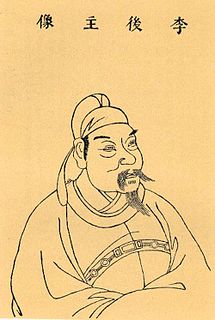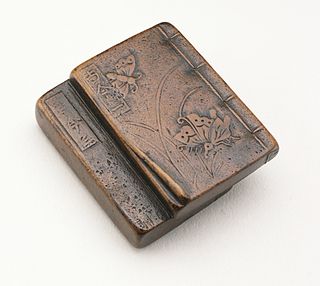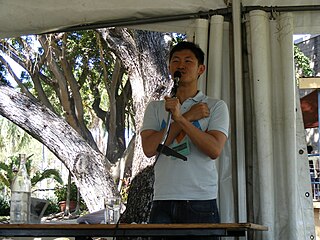Related Research Articles
Chinese classic texts or canonical texts or simply dianji (典籍) refers to the Chinese texts which originated before the imperial unification by the Qin dynasty in 221 BC, particularly the "Four Books and Five Classics" of the Neo-Confucian tradition, themselves a customary abridgment of the "Thirteen Classics". All of these pre-Qin texts were written in classical Chinese. All three canons are collectively known as the classics.
The Man'yōshū is the oldest extant collection of Japanese waka, compiled sometime after AD 759 during the Nara period. The anthology is one of the most revered of Japan's poetic compilations. The compiler, or the last in a series of compilers, is today widely believed to be Ōtomo no Yakamochi, although numerous other theories have been proposed. The chronologically last datable poem in the collection is from AD 759 (No. 4516). It contains many poems from a much earlier period, with the bulk of the collection representing the period between AD 600 and 759. The precise significance of the title is not known with certainty.

Imagism was a movement in early-20th-century Anglo-American poetry that favored precision of imagery and clear, sharp language. It is considered to be the first organized modernist literary movement in the English language. Imagism is sometimes viewed as "a succession of creative moments" rather than a continuous or sustained period of development. The French academic René Taupin remarked that "it is more accurate to consider Imagism not as a doctrine, nor even as a poetic school, but as the association of a few poets who were for a certain time in agreement on a small number of important principles".

Li Yu, before 961 known as Li Congjia (李從嘉), also known as Li Houzhu, was the third ruler of the Southern Tang state during imperial China's Five Dynasties and Ten Kingdoms period. He reigned from 961 until 976, when he was captured by the invading Song dynasty armies which annexed his kingdom. He died by poison on orders of Emperor Taizong of Song after 2 years essentially as an exiled prisoner.

The Classic of Poetry, also Shijing or Shih-ching, translated variously as the Book of Songs, Book of Odes or simply known as the Odes or Poetry, is the oldest existing collection of Chinese poetry, comprising 305 works dating from the 11th to 7th centuries BC. It is one of the "Five Classics" traditionally said to have been compiled by Confucius, and has been studied and memorized by scholars in China and neighboring countries over two millennia. It is also a rich source of chengyu that are still a part of learned discourse and even everyday language in modern Chinese. Since the Qing dynasty, its rhyme patterns have also been analysed in the study of Old Chinese phonology.

Han Yu, courtesy name Tuizhi, and commonly known as Han Wengong (韩文公), was a Chinese historian, poet, philosopher, and politician during the Tang dynasty who significantly influenced the development of Neo-Confucianism. Described as "comparable in stature to Dante, Shakespeare or Goethe" for his influence on the Chinese literary tradition, Han Yu stood for strong central authority in politics and orthodoxy in cultural matters.
Wang Wei, also known by her courtesy name Xiuwei, was a Chinese courtesan, poet, and traveller during the late-Ming dynasty.

Japanese poetry is poetry typical of Japan, or written, spoken, or chanted in the Japanese language, which includes Old Japanese, Early Middle Japanese, Late Middle Japanese, and Modern Japanese, as well as poetry in Japan which was written in the Chinese language or ryūka from the Okinawa Islands: it is possible to make a more accurate distinction between Japanese poetry written in Japan or by Japanese people in other languages versus that written in the Japanese language by speaking of Japanese-language poetry. Much of the literary record of Japanese poetry begins when Japanese poets encountered Chinese poetry during the Tang dynasty. Under the influence of the Chinese poets of this era Japanese began to compose poetry in Chinese kanshi); and, as part of this tradition, poetry in Japan tended to be intimately associated with pictorial painting, partly because of the influence of Chinese arts, and the tradition of the use of ink and brush for both writing and drawing. It took several hundred years to digest the foreign impact and make it an integral part of Japanese culture and to merge this kanshi poetry into a Japanese language literary tradition, and then later to develop the diversity of unique poetic forms of native poetry, such as waka, haikai, and other more Japanese poetic specialties. For example, in the Tale of Genji both kanshi and waka are frequently mentioned. The history of Japanese poetry goes from an early semi-historical/mythological phase, through the early Old Japanese literature inclusions, just before the Nara period, the Nara period itself, the Heian period, the Kamakura period, and so on, up through the poetically important Edo period and modern times; however, the history of poetry often is different from socio-political history.
The literature of Singapore comprises a collection of literary works by Singaporeans. It is written chiefly in the country's four official languages: English, Malay, Standard Mandarin and Tamil.

Huang Zunxian, courtesy name Gongdu (公度), was a Chinese official, scholar, and writer, active during the late Qing dynasty. As a poet, he published more than a hundred poems. He was born in Jiayingzhou, now Mei County, Guangdong, and died 57 years later in the same place. His important contributions to China made him a recognised figure of his time, and a namesake foundation has been established in his honour. Huang's former residence is now marked as a public museum.
Ya'qub Bilbul (1920–2003) was an Iraqi Jewish writer. His literary works were published in Arabic, and he achieved recognition as early as 1936 after publishing an article in the Iraqi journal, Al-Hatif. Known for his naturalistic stories, he is considered one of the first writers of social realist fiction in Iraq, and a pioneer of the Iraqi novel and short story.
Tan Kim Ching, also known as Tan Kim Cheng, was a Chinese politician and businessman. He was the eldest of the three sons of Tan Tock Seng, the founder and financier of Tan Tock Seng Hospital. He was consul for Japan, Thailand and Russia, and was a member of the Royal Court of Siam. He was one of Singapore's leading Chinese merchants and was one of its richest men in Singapore at that time. He was also the first Asian member of the Straits Branch of the Royal Asiatic Society. After his father, Tan Tock Seng's death, he became the Kapitan Cina of the Straits Chinese community. He is believed to have been the head of the Triad in Malaya.

Ng Yi Sheng is a Singaporean gay writer. He has published a collection of his poems entitled last boy, which won the Singapore Literature Prize, and a documentary book on gay, lesbian and bisexual Singaporeans called SQ21: Singapore Queers in the 21st Century in 2006.
Gwee Li Sui is a poet, a graphic artist, and a literary critic from Singapore.

Ming poetry refers to the poetry of or typical of the Ming dynasty (1368–1644). With over one million specimens of Ming poetry surviving today, the poetry of the Ming dynasty represents one of the major periods of Classical Chinese poetry, as well as an area of active modern academic research. Ming poetry is marked by 2 transitional phases, the transition between the Yuan dynasty which was the predecessor to the Ming, and the Qing-Ming transition which eventually resulted in the succeeding Qing dynasty. Although in politico-dynastic terms, the dynastic leadership of China is historically relatively clear-cut, the poetic periods involved encompass the lifespans and works of poets whose lives and poetic output transcend both the end of one dynasty and the initiatory period of the next.
Xue Susu was a Chinese courtesan. Known as one of the "Eight Great Courtesans of the Ming Dynasty", she was an accomplished painter and poet, and was noted for her skill at mounted archery. She was particularly noted for her figure paintings, which included many Buddhist subjects. Her works are held in a number of museums both in China and elsewhere. Her archery was commented upon by a number of contemporary writers, as were her masculine, martial tendencies; these were regarded as an attractive feature by the literati of the period.
Gu Mei, better known by her art name Gu Hengbo, also known as Xu Mei and Xu Zhizhu after her marriage, was a Chinese courtesan, poet and painter. She received the title "Lady (furen)" from the early Qing court, and often addressed as "Lady Hengbo" in Qing writings.

"Zhang Hongjian" is a short story by the Chinese writer Pu Songling collected in Strange Tales from a Chinese Studio in 1740, and translated by Sidney L. Sondergard in 2012. Set in various parts of 18th-century China, the story revolves around the title character and his misadventures while on the run. Pu adapted the story into two of his plays.

The Eight Beauties of Qinhuai were eight famous courtesans during the Ming-Qing transition period who resided along the Qinhuai River in Nankin. As well as possessing great beauty, they were all skilled in literature, poetry, fine arts, dancing and music.
Tan Yuanchun was a prolific late-Ming scholar from Hubei. Tan Yuanchun's work remains as an important resource for modern scholars. He was an influential and best-selling author critic. Tan is known as one of the "Ming masters of close textual reading".
References
- 1 2 Kai-wing Chow (2004). Publishing, Culture, and Power in Early Modern China. Stanford University Press. p. 131. ISBN 978-0-8047-3368-7.
- 1 2 Daria Berg (2007). "Female Self-Fashioning in Late Imperial China". In Daria Berg (ed.). Reading China: fiction, history and the dynamics of discourse : essays in honour of professor Glen Dudbridge. BRILL. p. 246. ISBN 978-90-04-15483-4.